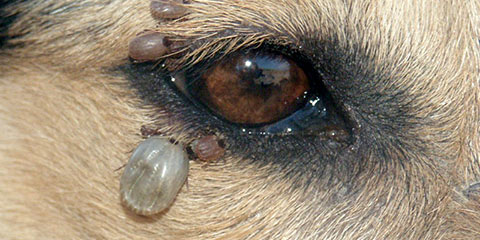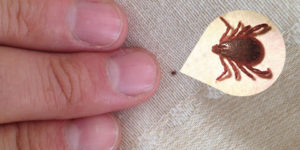
What are ticks?
Ticks are small arachnids (related to spiders), which are found practically everywhere, from forests to gardens to beaches. Tick numbers tend to be higher in certain areas, such as woodland, moorland, rough pasture and heathland. So if you regularly go walking in this type of area, your dog could be at significant risk of picking up a tick. We see many dogs who have picked up ticks at both our Torquay and Paignton surgeries.
Ticks jump onto dogs and cats (as well as other animals and humans), and become engorged as they take a blood meal. They are most active in spring and autumn, but can remain active all summer in cool damp areas. Dogs and cats do not generally notice the tick feeding, but they can be irritating. The main concern with tick’s feeding is transmission of disease. In the UK the main disease of concern is Lyme Disease, which is known to affect dogs and humans. Effective tick prevention is essential if your pet is traveling abroad, where there are even more serious diseases spread by ticks.
Prevention
Avoiding high risk areas when walking your dog, particularly during periods of peak tick activity during Spring and Autumn, can help. Carefully examining your dog after walks to identify and then remove ticks is important, as removal of ticks within 48 hours of attachment helps to reduce the risk of disease transmission. If you find a tick on your pet, it is best to remove it, and we can do this for you. It is very important that the head is removed, as if the body is pulled off and the head left in it can cause problems. Tick hooks are available from us which can be used to safely ‘twist’ the tick out.
As you can see in this photo, ticks can be tiny and very difficult to see on your pet, which is why we recommend using further control measures for pets that are at risk of exposure to ticks. There are prescription products available from us to help prevent problems from ticks. Most products kill ticks after they have attached and started to feed; they then die and drop off while small and hopefully before any transmission of disease. Some products also repel ticks, but none are 100% effective. Monthly tick protection is one of the benefits available within our Complete Care Club, allowing you to spread the cost of preventative healthcare.
Lyme disease in dogs
This disease is transmitted when an infected tick climbs on to the dog and starts to feed. The process of disease transmission generally takes around 48 hours, although it can occur more rapidly. In some dogs, infection does not cause any harmful effects but in others, a variety of symptoms can be seen. The most common signs are fever, lethargy, losing interest in food, lameness and joint swellings and there can be more serious effects. These signs can take a long time to develop, sometimes several months, after a dog is bitten by an infected tick. Diagnosis can be difficult, as the signs are similar to a wide range of other diseases.
As well as using the tick prevention measures described above, there is a dog vaccine against Lyme disease available. This vaccine is not included in your dog’s routine booster and cannot be given at the same time as their other injections. To vaccinate your dog against Lyme disease we need to see them for 2 injections given 3 weeks apart; after this they are given a top-up booster once a year. For further information, or to book your dog in for vaccination, please speak to a member of our team. Alternatively, you can book your dog in for vaccination online.

